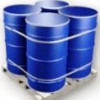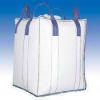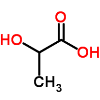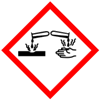| Anmol Chemicals is the pioneer manufacturers of Lactic Acid, Pharmaceutical Excipients Food & Flavor chemicals in India. We offer Halal and Kosher Lactic Acid made in an ISO9001, ISO22000 (FSSC22000) cGMP and GLP certified facility. Our group has several manufacturing facilities spread across the world, supported by toll manufacturers and representatives in UAE, Europe, Africa, USA, China and has several associated manufacturing facilities spread across India. All the Information on Physics, Chemistry, Applications, Uses and Technology on Manufacture of Lactic Acid is in these pages. |
| The units have one or more of the certifications like FDA GMP, ISO 9001, ISO 22000, HACCP, REACH, Kosher & Halal |





Lactic Acid SDS GHS, MSDS Sheet
Specifications of Lactic Acid Manufacturers
Lactic Acid SDS GHS, MSDS Sheet, Material Safety Data Sheet
1. Product Identification
Synonyms: 2-Hydroxypropionic acid
CAS No.: 50-21-5
EINECS EC Number: 200-018-0.
Molecular Weight: 90,08
Chemical Formula: C3H6O3
Recommended usage: Industrial Manufacturing.
Suppliers: As per letterhead above.
2. Hazards Identification
GHS, Globally Harmonized System Classification in accordance with 29 CFR 1910
Classification according to Regulation (EC) No 1272/2008
Skin corrosion/irritation Category (H315)
Serious eye damage/eye irritation Category 1 (H318)
Labeling according to GHS & Regulation (EC) No 1272/2008
GHS Label Elements  Corrosive |
Signal Words: Danger
Hazard Statements:
H315: Causes skin irritation.
H318: Causes serious eye damage.
Precautionary Statements:
P264: Wash … thoroughly after handling.
P280: Wear protective gloves/protective clothing/eye protection/face protection.
P360: Rinse immediately contaminated clothing and skin with plenty of water before removing clothes.
P362: Take off contaminated clothing and wash before reuse.
P302+352: IF ON SKIN: Wash with soap and water.
P332+313: If skin irritation occurs: Get medical advice/attention.
P305+351+338: IF IN EYES: Rinse cautiously with water for several minutes. Remove contact lenses if present and easy to do – continue rinsing.
P337+P313 If eye irritation persists: Get medical advice/ attention.
P314: Get Medical advice/attention if you feel unwell.
Classification according to EU Directives 67/548/EEC or 1999/45/EC:
Xi: Irritant.
R-phrase(s): R38 Irritating to skin. R41 Risk of serious damage to eyes.
S-phrase(s): S26 In case of contact with eyes, rinse immediately with plenty of water and seek medical advice. S39 Wear eye/face protection.
Full text of S-statement & R-phrases: see section 16
3. Composition/Information on Ingredients
Ingredient: Lactic Acid
CAS No.: 50-21-5
EINECS EC Number: 200-018-0.
4. First Aid Measures
Always seek medical advice after the first aid treatment.
Inhalation: Remove to fresh air. If not breathing, give artificial respiration. If breathing is difficult, give oxygen. Call a physician immediately.
Ingestion: DO NOT INDUCE VOMITING. Give large quantities of water. Never give anything by mouth to an unconscious person. Call a physician immediately.
Skin Contact: In case of contact with Lactic Acid, wipe off excess material from skin then immediately flush skin with plenty of water for at least 15 minutes. Remove contaminated clothing and shoes. Wash clothing before reuse. Call a physician immediately.
Eye Contact: Immediately flush eyes with gentle but large stream of water for at least 15 minutes, lifting lower and upper eyelids occasionally. Call a physician immediately.
5. Fire Fighting Measures
Fire: Lactic Acid is not considered to be a fire hazard. Use water spray, alcohol-resistant foam, dry chemical or carbon dioxide. Use means suitable for extinguishing surrounding fire.
Explosion: Not considered to be an explosion hazard.
Fire Extinguishing Media: Use water spray, alcohol-resistant foam, dry chemical or carbon dioxide.
Special Information: Wear self-contained breathing apparatus and protective clothing to prevent contact with skin and clothing.
6. Accidental Release Measures
Ventilate area of leak or spill. Keep unnecessary and unprotected people away from area of spill. Avoid breathing vapors, mist or gas. Ensure adequate ventilation. Wear appropriate personal protective equipment.
Spills: Pick up and place in a suitable container for reclamation or disposal, using a method that does not generate dust. Do not flush caustic residues to the sewer. Carefully pick up solid with minimum of dusting and collect in metal container with covers with disposal. The trace amount of residue of Lactic Acid can be flushed down drain.
7. Handling and Storage
Keep in a tightly closed container, stored in a cool, dry, ventilated area. Protect against physical damage. Isolate from incompatible substances. Containers of this material may be hazardous when empty since they retain product residues (dust, solids). Do not get in eyes, on skin, on clothing. Wash thoroughly after handling. Store away from acids.
8. Exposure Controls/Personal Protection
Airborne Exposure Limits: This product does not contain any hazardous materials with occupational exposure limits established by the region specific regulatory bodies.
Ventilation System: A system of local and/or general exhaust is recommended to keep employee exposures below the Airborne Exposure Limits. Local exhaust ventilation is generally preferred because it can control the emissions of the contaminant at its source, preventing dispersion of it into the general work area.
Personal Respirators (NIOSH Approved): If the exposure limit is exceeded and engineering controls are not feasible, a full face piece particulate respirator (NIOSH type N100 filters) may be worn for up to 50 times the exposure limit or the maximum use concentration specified by the appropriate regulatory agency or respirator supplier, whichever is lowest. If oil particles (e.g. lubricants, cutting fluids. glycerin, etc.) are present, use a NIOSH type R or P filter. For emergencies or instances where the exposure levels are not known, use a full-face piece positive-pressure, air-supplied respirator. WARNING: Air-purifying respirators do not protect workers in oxygen-deficient atmospheres.
Skin Protection: Wear impervious protective clothing, including boots, gloves, lab coat, apron or coveralls, as appropriate, to prevent skin contact.
Eye Protection: Use chemical safety goggles and/or full face shield where dusting or splashing of solutions is possible. Maintain eye wash fountain and quick-drench facilities in work area.
9. Physical and Chemical Properties
Appearance: Lactic Acid viscous liquid.
Odor: Odorless.
Solubility: Soluble in water.
Specific Gravity: 1.2
pH: <1
% Volatiles by volume @ 21C (70F): 0
Boiling Point: 122C.
Melting Point - Freezing Point: 17-33C (1076F)
Molecular Formula:C3H6O3
Molecular Weight:90.08
10. Stability and Reactivity
Stability: Lactic Acid is stable under ordinary conditions of use and storage.
Hazardous Decomposition Products: Carbon oxides.
Hazardous Polymerization: Will not occur.
Incompatibilities: Metals, strong oxidizing agents, strong reducing agents, strong bases, nitric, acid, iodides.
Conditions to Avoid: Excess heat, exposure to moist air or water and incompatibilities.
11. Toxicological Information
Oral, mouse: LD50 = 4875 mg/kg
Oral Rat LD50: 3543 mg/kg
Dermal Rabbit LD50: >2 g/kg
Carcinogenic Effects: Not a reported carcinogen by IARC, NTP, ACGIH, OSHA.
Epidemiology: No information found
Teratogenicity: No information found
Reproductive Effects: No information found
Mutagenicity: Mutation in bacteria.
Neurotoxicity: No information found
12. Ecological Information
Environmental Fate: Lactic Acid is not expected to significantly bio accumulate.
Results of PBT and vPvB assessment: This substance/mixture contains no components considered to be either persistent, bioaccumulative and toxic (PBT), or very persistent and very bioaccumulative (vPvB) at levels of 0.1% or higher.
13. Disposal Considerations
Although not a listed RCRA hazardous waste, Lactic Acid may exhibit one or more characteristics of a hazardous waste and require appropriate analysis to determine specific disposal requirements. Dispose of container and unused contents in accordance with federal, state and local requirements.
14. Transport Information
DOT USA: Not dangerous goods
ADR/RID: Not dangerous goods
IMDG: Not dangerous goods
IATA: Not dangerous goods
15. Regulatory Information
USA:
SARA 302: Not Listed
SARA 313: Not Listed
SARA 311/312: Acute Health Hazard.
OSHA: Not applicable
Canada WHMIS: CLASS E: Corrosive material. D2B Toxic material.
Canada DSL: Lactic Acid (50-21-5) -- Yes
Canada NDSL: Lactic Acid (50-21-5) - Yes
Canadian Ingredient Disclosure List: CAS# 50-21-5 is listed on the Canadian Ingredient Disclosure List.
Section 16 - Additional Information
EINECS EC Number: 200-018-0.
H315 = Causes skin irritation.
H318 = Causes serious eye damage.
H332 = Harmful if inhaled.
H335 = May cause respiratory irritation.
H402 = Harmful to aquatic life.
Xi  Irritant; R37/38 Irritating to respiratory system and skin; R41 Risk of serious damage to eyes.
Disclaimer:
**********************************
Our company provides this MSDS sheet in good faith but makes no representation as to its comprehensiveness or accuracy. This SDS sheet is intended only as a guide to the appropriate precautionary handling of the material by a properly trained person using this product. The above information has been compiled from various sources and has the possibility of discrepancy and being out-dated information. Individuals receiving the information must exercise their independent judgment and do further search in determining its appropriateness for a particular purpose. In no case shall our company be liable to loss or damages by the product user.
**********************************
Lactic Acid manufacturers
Anmol Chemicals
S-8, SARIFA MANSION, 2ND FLANK ROAD, CHINCHBUNDER, MUMBAI 400009, INDIA
TEL: (OFFICE) 91-22-23770100, 23726950, 23774610, 23723564 - FAX: 91-22-23728264
e-mail: anmolc@mtnl.net.in

Exports to USA, Canada, UAE, Dubai, South Africa, Tanzania, Kenya, Nigeria, Egypt, Uganda, Turkey, Mexico, Brazil, Chile, Argentina, Europe Netherlands, Italy, Spain, Germany, Portugal, France, Malaysia, Indonesia, Thailand, Vietnam, Korea, Japan, etc.
Copyright and Usual Disclaimer is Applicable. 20 January, 2022